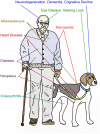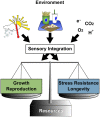Why is aging conserved and what can we do about it?
- PMID: 25923592
- PMCID: PMC4414409
- DOI: 10.1371/journal.pbio.1002131
Why is aging conserved and what can we do about it?
Erratum in
-
Correction: Why Is Aging Conserved and What Can We Do about it?PLoS Biol. 2015 May 15;13(5):e1002176. doi: 10.1371/journal.pbio.1002176. eCollection 2015 May. PLoS Biol. 2015. PMID: 25978048 Free PMC article.
Abstract
The field of aging research has progressed rapidly over the past few decades. Genetic modulators of aging rate that are conserved over a broad evolutionary distance have now been identified. Several physiological and environmental interventions have also been shown to influence the rate of aging in organisms ranging from yeast to mammals. Here we briefly review these conserved pathways and interventions and highlight some key unsolved challenges that remain. Although the molecular mechanisms by which these modifiers of aging act are only partially understood, interventions to slow aging are nearing clinical application, and it is likely that we will begin to reap the benefits of aging research prior to solving all of the mysteries that the biology of aging has to offer.
Conflict of interest statement
The authors have declared that no competing interests exist.
Figures


References
Publication types
MeSH terms
Grants and funding
LinkOut - more resources
Full Text Sources
Other Literature Sources
Medical
Molecular Biology Databases
Miscellaneous

